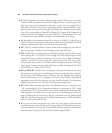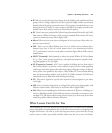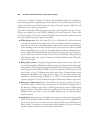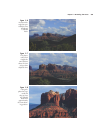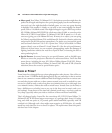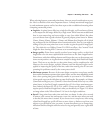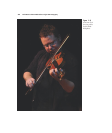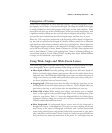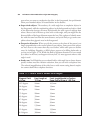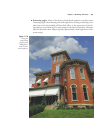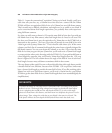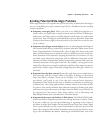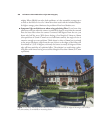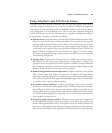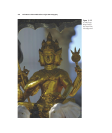
great when you want to emphasize that lake in the foreground, but problematic
when your intended subject is located farther in the distance.
■ Super-sized subjects. The tendency of a wide-angle lens to emphasize objects in
the foreground, while de-emphasizing objects in the background can lead to a kind
of size distortion that may be more objectionable for some types of subjects than
others. Shoot a bed of flowers up close with a wide angle, and you might like the
distorted effect of the larger blossoms nearer the lens. Take a photo of a family mem-
ber with the same lens from the same distance, and you’re likely to get some com-
plaints about that gigantic nose in the foreground.
■ Perspective distortion. When you tilt the camera so the plane of the sensor is no
longer perpendicular to the vertical plane of your subject, some parts of the subject
are now closer to the sensor than they were before, while other parts are farther
away. So, buildings, flagpoles, or NBA players appear to be falling backwards, as
you can see in Figure 11.10. While this kind of apparent distortion (it’s not caused
by a defect in the lens) can happen with any lens, it’s most apparent when a wide
angle is used.
■ Steady cam. You’ll find that you can hand-hold a wide-angle lens at slower shutter
speeds, without need for vibration reduction, than you can with a telephoto lens.
The reduced magnification of the wide-lens or wide-zoom setting doesn’t empha-
size camera shake like a telephoto lens does.
David Busch’s Nikon D7000 Guide to Digital SLR Photography364
Table 11.1 Field of View at Various Focal Lengths
Diagonal Field Focal Length at Focal Length Needed to Produce
of View 1X Crop Same Field of View at 1.5X Crop
107 degrees 16mm 10.5mm
94 degrees 20mm 13mm
84 degrees 24mm 16mm
75 degrees 28mm 19mm
63 degrees 35mm 23mm
47 degrees 50mm 33mm
28 degrees 85mm 56mm
18 degrees 135mm 90mm
12 degrees 200mm 133mm
8.2 degrees 300mm 200mm



